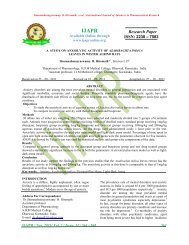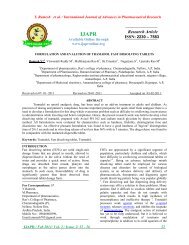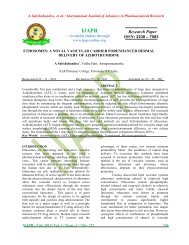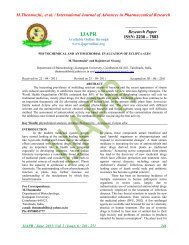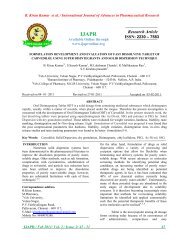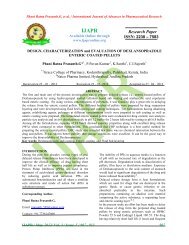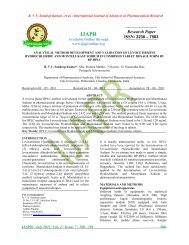20110802_Shailesh T. Prajapati et al, IJAPR.pdf - international ...
20110802_Shailesh T. Prajapati et al, IJAPR.pdf - international ...
20110802_Shailesh T. Prajapati et al, IJAPR.pdf - international ...
You also want an ePaper? Increase the reach of your titles
YUMPU automatically turns print PDFs into web optimized ePapers that Google loves.
<strong>Shailesh</strong> T. <strong>Prajapati</strong>., <strong>et</strong> <strong>al</strong>. / Internation<strong>al</strong> Journ<strong>al</strong> of Advances in Pharmaceutic<strong>al</strong> Research<br />
<strong>IJAPR</strong><br />
Available Online through<br />
www.ijapronline.org<br />
Review Article<br />
ISSN: 2230 – 7583<br />
PEGYLATION: AN APROACH FOR PROTEIN AND PEPTIDE DRUG DELIVERY SYSTEMS<br />
<strong>Shailesh</strong> T. <strong>Prajapati</strong>*, Amit N. Patel, Chhagan N. Patel<br />
Shri Sarvajanik Pharmacy College, Mehsana - 384 001, India.<br />
Received on 20 – 04 - 2011 Revised on 21 – 05- 2011 Accepted on 01 – 06 – 2011<br />
ABSTRACT<br />
A number of novel drug-delivery mechanisms have been developed to increase the utility of drugs having poor<br />
solubility, distribution and permeation, one of them is PEGylation. PEGylation defines the modification of a protein,<br />
peptide or non-peptide molecule by the linking of one or more poly<strong>et</strong>hylene glycol (PEG) chains. PEGylated<br />
products gener<strong>al</strong>ly have longer plasma h<strong>al</strong>f-lives and durations of bioactivity than their non PEGylated counterparts.<br />
Pegylation now play the important role in drug delivery and enhancing the potenti<strong>al</strong> of peptide and protein drugs.<br />
INTRODUCTION<br />
A number of novel drug-delivery mechanisms have<br />
been developed to increase the utility of drugs that<br />
are otherwise limited by suboptim<strong>al</strong> pharmacokin<strong>et</strong>ic<br />
properties, such as poor absorption, distribution, and<br />
elimination. These include continuous-release<br />
injectable and liposom<strong>al</strong> systems, which <strong>al</strong>ter the<br />
formulation of the drug, and PEGylation, which <strong>al</strong>ters<br />
the drug molecule. [1]<br />
PEGylation defines the modification of a protein,<br />
peptide or non-peptide molecule by the linking of one<br />
or more poly<strong>et</strong>hylene glycol (PEG) chains. This<br />
polymer is nontoxic, non-immunogenic, nonantigenic,<br />
highly soluble in water and FDA approved.<br />
The PEG-drug conjugates have sever<strong>al</strong> advantages: a<br />
prolonged residence in body, a decreased degradation<br />
by m<strong>et</strong>abolic enzymes and a reduction or elimination<br />
of\protein immunogenicity. Thanks to these favorable<br />
properties, PEGylation now plays an important role<br />
in drug delivery, enhancing the potenti<strong>al</strong>s of peptides<br />
and proteins as therapeutic agents. [2]<br />
Corresponding Author:<br />
Dr. <strong>Shailesh</strong> T. <strong>Prajapati</strong>,<br />
Shri Sarvajanik Pharmacy College,<br />
Mehsana- 384 001, India;<br />
Mob:+91 9924456583,<br />
Email: stprajapati@gmail.com<br />
PEGylation was first described in the 1970s by<br />
Davies and Abuchowsky and reported in two key<br />
papers on <strong>al</strong>bumin and cat<strong>al</strong>ase modification. This<br />
was an important milestone, because at that time it<br />
was not conceivable to modify an enzyme so<br />
extensively and still maintain its activity. Proteins<br />
were in fact considered very delicate entities and only<br />
few gentle modifications with low molecular-weight<br />
products were carried out, mainly to study SARs. [2]<br />
PEGylation is a new delivery technology that differs<br />
from tradition<strong>al</strong> formulation in a number of ways.<br />
Formulated products such as tabl<strong>et</strong>s, liquids and<br />
capsules, the formulation process is reversible, the<br />
drug becomes active after its release from the<br />
formulation and the API remains unchanged. In<br />
PEGylated products, on the other hand, the API is<br />
chemic<strong>al</strong>ly modified in a durable fashion, and the<br />
drug is not released from a formulation but has a<br />
permanent action and is in fact classed as a new API.<br />
Consequently, PEGylation has to be considered early<br />
in the drug development process. [2]<br />
The advantages conferred by PEGylation include an<br />
increased molecule weight and hydrodynamic<br />
volume and a masking of the surface of the molecule<br />
with highly mobile PEG chains. PEGylation <strong>al</strong>so<br />
reduces the rapid ren<strong>al</strong> clearance of sm<strong>al</strong>l proteins<br />
and makes it possible for liposomes to evade remov<strong>al</strong><br />
from the plasma by lipolytic enzymes and the<br />
r<strong>et</strong>iculoendotheli<strong>al</strong> system. As a result, pegylated<br />
agents gener<strong>al</strong>ly have longer plasma h<strong>al</strong>f-lives and<br />
<strong>IJAPR</strong> / June 2011/ Vol. 2 / Issue. 6 / 252 - 262 252
<strong>Shailesh</strong> T. <strong>Prajapati</strong>., <strong>et</strong> <strong>al</strong>. / Internation<strong>al</strong> Journ<strong>al</strong> of Advances in Pharmaceutic<strong>al</strong> Research<br />
durations of bioactivity than their nonpegylated<br />
counterparts and benefits of pegylated product given<br />
in table 1. [1]<br />
PROPERTIES OF PEG<br />
Poly<strong>et</strong>hylene glycols are pH-neutr<strong>al</strong>, nontoxic watersoluble<br />
polymers that consist of repeating <strong>et</strong>hylene<br />
oxide subunits, each with a molecular weight of 44,<br />
and two termin<strong>al</strong> hydroxyl groups. They are either<br />
linear (5 to 30 kd) or branched (40 to 60 kd) chain<br />
structures.PEG has Poly-dispersity i.e. Molecular<br />
weight distribution is narrow (1.01 – 1.1). The<br />
pharmacokin<strong>et</strong>ic properties of PEGs vary according<br />
to their molecular weight and site of injection. The<br />
area under the time-concentration curve and the h<strong>al</strong>flife<br />
of PEGs increase with their molecular weight.<br />
For example, after intravenous administration in mice<br />
the h<strong>al</strong>f-life of 50kd PEG is substanti<strong>al</strong>ly longer than<br />
that of 6 kd PEG (987vs 17.6 minutes); 50kd PEG is<br />
<strong>al</strong>so r<strong>et</strong>ained longer at the injection site after<br />
subcutaneous or intramuscular injection than is 6 kd<br />
PEG. Poly<strong>et</strong>hylene glycols appear to undergo<br />
oxidation by the cytochrome P450 enzyme system,<br />
and lowmolecular- weight PEGs are excr<strong>et</strong>ed into the<br />
bile. [1]<br />
PEGylation – MECHANISM OF ACTION<br />
After administration, when PEG comes in contact of<br />
aqueous environment, <strong>et</strong>hylene glycol sub-unit g<strong>et</strong>s<br />
tightly attached to the water molecule. This binding<br />
to water renders them high mobility and hydration.<br />
Hydration and rapid motion causes PEGylated<br />
protein to function, as it causes PEG to sweep out a<br />
large volume which acts like a shield to protect the<br />
attached drug from enzymatic degradation and<br />
interaction with cell surface proteins. This increased<br />
size <strong>al</strong>so helps to prevent rapid ren<strong>al</strong> filtration and<br />
clearance sustaining the drug bioavailability. The<br />
high steric hindrance of branched-chain PEGs<br />
gener<strong>al</strong>ly affords greater protection than do linear<br />
chain. [1]<br />
FACTORS AFFECTING PERFORMANCE OF<br />
PEGylated PRODUCT<br />
Molecular Weight<br />
Molecular weight less than 1000 Da of PEG broken<br />
down into sub-units, and have some toxicity, while<br />
Molecular weight greater than 1000 Da of PEG: does<br />
not demonstrate any toxicity in vivo.<br />
Molecular Weight upto 40,000 – 50,000 Da: used in<br />
clinic<strong>al</strong> and approved pharmaceutic<strong>al</strong> application.<br />
The molecular weight of PEG has a direct impact on<br />
the activity; Higher molecular weight PEGs tends to<br />
have higher in-vivo activity due to the improved<br />
pharmacokin<strong>et</strong>ic profile like increasing h<strong>al</strong>f life as<br />
earlier discussed. [1]<br />
Structure<br />
Branched structure has more size than same<br />
molecular weight linear structure so; it’s <strong>al</strong>so helps to<br />
prevent rapid ren<strong>al</strong> filtration and clearance sustaining<br />
the drug bioavailability. The high steric hindrance of<br />
branched-chain PEGs gener<strong>al</strong>ly affords greater<br />
protection than do linear chain. [1,4]<br />
Number of PEG chains<br />
Two or more lower molecular weight chains can be<br />
added to increase tot<strong>al</strong> molecular weight of PEG<br />
complex<br />
Specific location of PEG site of attachment to the<br />
molecule.<br />
Optim<strong>al</strong> PEGylation is product-specific, and can vary<br />
depending on the site of attachment, the chemistry<br />
used to create the conjugate, and the characteristics of<br />
the PEG used. Effective PEGylation of a drug may<br />
be achieved by attaching a single large PEG at a<br />
single site, a branched PEG at a single site, or sever<strong>al</strong><br />
sm<strong>al</strong>l PEG chains at sever<strong>al</strong> sites. [1]<br />
CHEMISTRY OF PEGYLATION<br />
To couple PEG to a molecule (i.e. polypeptides,<br />
polysaccharides, polynucleotide’s and sm<strong>al</strong>l organic<br />
molecules) as shown in Figure 1, it is necessary to<br />
activate the PEG by preparing a derivative of the<br />
PEG having a function<strong>al</strong> group at one or both<br />
termini. The function<strong>al</strong> group is chosen based on the<br />
type of available reactive group on the molecule that<br />
will be coupled to the PEG. For proteins, typic<strong>al</strong><br />
reactive amino acids include lysine, cysteine,<br />
histidine, arginine, aspartic acid, glutamic acid,<br />
serine, threonine, tyrosine, N-termin<strong>al</strong> amino group<br />
and the C-termin<strong>al</strong> carboxylic acid. In the case of<br />
glycoproteins, vicin<strong>al</strong> hydroxyl groups can be<br />
oxidized with periodate to form two reactive formyl<br />
moi<strong>et</strong>ies. [3]<br />
The most common route for PEG conjugation of<br />
proteins has been to activate the PEG with function<strong>al</strong><br />
groups suitable for reaction with lysine and N-<br />
termin<strong>al</strong> amino acid groups. Lysine is one of the most<br />
prev<strong>al</strong>ent amino acids in proteins and can be upwards<br />
of 10% of the over<strong>al</strong>l amino acid sequence. In<br />
reactions b<strong>et</strong>ween electrophilic<strong>al</strong>ly activated PEG<br />
and nucleophilic amino acids, it is typic<strong>al</strong> that sever<strong>al</strong><br />
amines are substituted. When multiple lysines have<br />
been modified, a h<strong>et</strong>erogeneous mixture is produced,<br />
which is composed of a population of sever<strong>al</strong><br />
poly<strong>et</strong>hylene glycol molecules attached per protein<br />
molecule (‘PEGmers’) ranging from zero to the<br />
number of ´-and a-amine groups in the protein. [3]<br />
PEGylation technology is classified into two types:<br />
1. Early PEGylation technology (First<br />
generation PEGylation)<br />
<strong>IJAPR</strong> / June 2011/ Vol. 2 / Issue. 6 / 252 - 262 253
<strong>Shailesh</strong> T. <strong>Prajapati</strong>., <strong>et</strong> <strong>al</strong>. / Internation<strong>al</strong> Journ<strong>al</strong> of Advances in Pharmaceutic<strong>al</strong> Research<br />
2. Advanced PEGylation technology (Second<br />
generation PEGylation)<br />
1. First Generation PEGylation<br />
First generation PEGylation m<strong>et</strong>hods were fraught<br />
with difficulties.<br />
With first generation PEGylation, the PEG polymer<br />
was gener<strong>al</strong>ly attached to ε amino group of lysine,<br />
and gave mixtures of PEG isomers with different<br />
molecular masses. The existence of these isomers<br />
makes it difficult to reproduce drug batches, and can<br />
contribute to the antigenecity of the drug and poor<br />
clinic<strong>al</strong> outcomes. In addition, first generation<br />
m<strong>et</strong>hods mainly used linear PEG polymers of 12 kDa<br />
or less. Unstable bonds b<strong>et</strong>ween the drug and PEG<br />
were <strong>al</strong>so som<strong>et</strong>imes used, which leads to<br />
degradation of PEG-drug conjugate during<br />
manufacturing and injection Early PEGylation was<br />
performed with m<strong>et</strong>hoxy-PEG (m-PEG), which was<br />
contaminated with PEG diol and which resulted in<br />
the cross-linking of proteins to form inactive<br />
aggregates. Diol contamination can reach upto 10-15<br />
%. [1]<br />
Despite these limitations, sever<strong>al</strong> first generation<br />
PEGylated drugs receive regulatory approv<strong>al</strong>.<br />
Example: Still in use today are Pegademase<br />
(ADAGEN ® ), a PEGylated form of the enzyme<br />
adenosine de-aminase for the treatment of Severe<br />
Combined Immuno-Deficiency (SCID) and<br />
Pegaspargase (ONCASPAR ® ), a PEGylated form of<br />
enzyme asparginase for the treatment of Leukemia. [5]<br />
2. Second Generation PEGylation<br />
Second generation PEGylation strives to avoid<br />
pitf<strong>al</strong>ls associated with the first generation<br />
PEGylation.<br />
Over<strong>al</strong>l go<strong>al</strong> of this technology is to create larger<br />
PEG polymers to improve the Pharmacokin<strong>et</strong>ics and<br />
Pharmacodynamic effects seen with lower molecular<br />
mass PEGs.<br />
Newer pegylation m<strong>et</strong>hods create conjugates with<br />
strong linkages that are resistant to side-reactions and<br />
are able to withstand purification to remove dio1<br />
contaminants, thereby making it possible to use high<br />
molecular- weight PEGs . These m<strong>et</strong>hods attach an<br />
activated PEG to the drug molecule by incorporating<br />
part of the activating group as a link b<strong>et</strong>ween the two<br />
entities. For example, PEGFILGRASTIM ® is formed<br />
by cov<strong>al</strong>ently attaching a 20 kd PEG chain through a<br />
stable secondary amine bond directly to the termin<strong>al</strong><br />
amino group of the filgrastim molecule. In this way,<br />
the nitrogen atom to which the PEG chain is attached<br />
r<strong>et</strong>ains its surface charge, a factor that has been<br />
shown to be cruci<strong>al</strong> in conserving the bioactivity of<br />
some molecules. [1]<br />
Amine PEGylation and N-termin<strong>al</strong> PEGylation<br />
Since most applications of PEG conjugation involve<br />
labile molecules, the coupling reaction gener<strong>al</strong>ly<br />
requires mild chemic<strong>al</strong> conditions. In case of<br />
polypeptides, the most common reactive groups<br />
involved in coupling are nucleophiles with the<br />
following decreasing rank order of reactivity: thiol,<br />
<strong>al</strong>pha amino group, epsilon amino group,<br />
carboxylate, hydroxylate. However, this order is not<br />
absolute, since it depends <strong>al</strong>so on the reaction pH,<br />
furthermore other residues may react in speci<strong>al</strong><br />
conditions, as the imidazole group of histidine. The<br />
thiol group is rarely present in proteins, furthermore<br />
it is often involved in active sites. The carboxylic<br />
groups cannot be easily activated without having.<br />
reaction with the protein amino groups, to yield intra<br />
or inter molecular cross linking. Therefore, amino<br />
groups, namely the <strong>al</strong>pha amino or the epsilon amino<br />
of lysine, are the usu<strong>al</strong> sites of PEG linking. [4]<br />
PEGylating Agents used for amino PEGylation<br />
shown in Table 2.<br />
Carboxyl PEGylation<br />
PEG reagents react with carboxylic acid in the<br />
presence of coupling agents such as<br />
DCC (N,N'-dicyclohexylcarbodiimide) and EDIC (N-<br />
(3-dim<strong>et</strong>hylaminopropyl)-N' <strong>et</strong>hylcarbodiimide, HCl<br />
s<strong>al</strong>t). However, the procedure is successful only when<br />
amines are not present in the compound, as for<br />
instance in the case of non-peptide drugs. In peptides<br />
and proteins the risk of cross-linking is difficult to<br />
avoid. [3] PEGylating Agents used for Carboxyl<br />
PEGylation are shown in Table 3.<br />
PEGylation at the –SH (thiol) groups of Cysteine of<br />
polypeptides<br />
PEGylation of free cysteine residues in proteins is the<br />
main approach for site-specific modification because<br />
reagents that specific<strong>al</strong>ly react with cysteines have<br />
been synthesized, and the number of free cysteines on<br />
the surface of a protein is much less than that of<br />
lysine residues. In the absence of a free cysteine in a<br />
native protein, one or more free cysteines can be<br />
added by gen<strong>et</strong>ic engineering. PEGylating site<br />
specific<strong>al</strong>ly can minimize the loss of biologic<strong>al</strong><br />
activity and reduce immunogenecity. [3] PEGylating<br />
Agents used for thiol PEGylation are shown in Table<br />
3.<br />
Hydroxyl PEGylation<br />
PEG-isocyanate is useful for hydroxyl group<br />
conjugation yielding a stable ur<strong>et</strong>hane linkage.<br />
However, its reactivity may be best exploited for<br />
non-peptide moi<strong>et</strong>ies such as drugs or hydroxylcontaining<br />
matrices to yield biocompatible surfaces.<br />
PEG-isocyanate is in fact highly reactive with amines<br />
<strong>al</strong>so. [3] PEGylating Agents used for Hydroxyl<br />
PEGylation are shown in Table 3.<br />
H<strong>et</strong>ero-bifunction<strong>al</strong> PEGs<br />
<strong>IJAPR</strong> / June 2011/ Vol. 2 / Issue. 6 / 252 - 262 254
<strong>Shailesh</strong> T. <strong>Prajapati</strong>., <strong>et</strong> <strong>al</strong>. / Internation<strong>al</strong> Journ<strong>al</strong> of Advances in Pharmaceutic<strong>al</strong> Research<br />
As applications of PEG chemistry have become more<br />
sophisticated, there has been an increasing need for<br />
h<strong>et</strong>erobifunction<strong>al</strong> PEGs, which are PEGs bearing<br />
dissimilar termin<strong>al</strong> groups. Such h<strong>et</strong>erobifunction<strong>al</strong><br />
PEGs bearing appropriate function<strong>al</strong> groups may be<br />
used to link two entities where a hydrophilic, flexible,<br />
and biocompatible spacer is needed.<br />
H<strong>et</strong>erobifunction<strong>al</strong> PEG can be used in a vari<strong>et</strong>y of<br />
ways that includes linking macromolecules to<br />
surfaces (for immunoassays, biosensors or various<br />
probe applications), targ<strong>et</strong>ing of drugs, liposomes and<br />
viruses to specific tissues, liquid phase peptide<br />
synthesis and many others. Preferred end groups for<br />
h<strong>et</strong>ero-bifunction<strong>al</strong> PEGs are NHS esters, m<strong>al</strong>eimide,<br />
vinyl sulfone, pyridyl disulfide, amine, and<br />
carboxylic acids. [3]<br />
Branched structures<br />
Second generation PEGylation uses branched<br />
structures of PEG, in contrast to the solely linear<br />
structures found in first generation PEGs. Branched<br />
PEGs of greatly increased molecular masses – upto<br />
60 kDa or more, as compared with the 12 kDa or less<br />
found in the first generation PEGs – have been<br />
prepared. A branched PEG ‘acts’ as if it were much<br />
larger than a corresponding linear PEG of the same<br />
molecular mass. Branched PEGs are <strong>al</strong>so b<strong>et</strong>ter at<br />
cloaking the attached polypeptide drug from the<br />
immune system and proteolytic enzymes, thereby<br />
reducing its antigenecity and likelihood of<br />
destruction. [1,3]<br />
Specific PEGylation by enzymes or by reversible<br />
protection<br />
The specific conjugation of PEG to the amide group<br />
of glutamines or to the hydroxyl group of serines and<br />
threonines is only possible under mild conditions<br />
using enzymes. Sato discovered that glutamine in<br />
proteins can be the substrate of the transglutaminase<br />
enzymes, if an amino PEG is used as the nucleophilic<br />
donor. Through a transglutamination reaction the<br />
enzyme links PEG to the protein at the level of the<br />
glutamine residue as shown in Figure 2. [2] Now a<br />
days, PEG conjugates with different enzyme like<br />
arginines n histaminase are <strong>al</strong>so available.<br />
LIMITATIONS IN TH USE OF PEG<br />
PEG is obtained by chemic<strong>al</strong> synthesis and, like <strong>al</strong>l<br />
synth<strong>et</strong>ic polymers, it is polydisperse, which means<br />
that the polymer’s batch is composed of molecules<br />
having different number of monomers, yielding a<br />
Gaussian distribution of the molecular weights. This<br />
leads to a population of drug conjugates, which<br />
might have different biologic<strong>al</strong> properties, mainly in<br />
body-residence time and immunogenicity.<br />
Polydispersivity problem must be still taken into<br />
consideration, especi<strong>al</strong>ly when de<strong>al</strong>ing with low<br />
molecular weight drugs, either peptide or nonpeptide<br />
drugs, where the mass of linked PEG is more<br />
relevant for conveying the conjugate’s<br />
characteristics, mainly those related to the molecular<br />
size. A second problem for the use of this polymer<br />
relates to the excr<strong>et</strong>ion from the body. As for other<br />
polymers, PEGs are usu<strong>al</strong>ly excr<strong>et</strong>ed in urine or<br />
feces but at high molecular weights they can<br />
accumulate in the liver, leading to macromolecular<br />
syndrome. [2]<br />
APPLICATION OF PEGYLATION<br />
PEG as Diagnostic Carrier<br />
In vivo non invasive diagnosis is done by using<br />
tracers d<strong>et</strong>ected through magn<strong>et</strong>ic resonance or<br />
radioactivity. Usu<strong>al</strong>ly they are administered in a<br />
chelated form using compounds that can give<br />
specific biodistribution, stability or targ<strong>et</strong>ing.<br />
PEGylation increases the body-residence time of<br />
paramagn<strong>et</strong>ic chelates that will be cleared more<br />
slowly than the unmodified molecules through the<br />
kidney or liver, thus <strong>al</strong>lowing more d<strong>et</strong>ailed images<br />
by magn<strong>et</strong>ic resonance. C225 is a monoclon<strong>al</strong><br />
antibody directed against the epiderm<strong>al</strong> growth factor<br />
receptor, which was conjugated to a<br />
h<strong>et</strong>erobifunction<strong>al</strong> PEG bearing a radiom<strong>et</strong><strong>al</strong> chelator<br />
(di<strong>et</strong>hylen<strong>et</strong>riaminepentaac<strong>et</strong>ic acid, DTPA) at one<br />
terminus. The conjugate DTPA–PEG–C225 r<strong>et</strong>ained<br />
66% of binding affinity, and, more importantly,<br />
when labeled with Indium-111 (111In) it showed<br />
narrower steady-state distribution than the non-<br />
PEGylated 111In–DTPA–C225, because of reduced<br />
nonspecific binding. Therefore, in case of protein<br />
targ<strong>et</strong>ed diagnostic, PEG could help to collect b<strong>et</strong>ter<br />
defined images by limiting the background noise due<br />
to nonspecific protein–protein interaction. [2]<br />
PEG oligonucleotides<br />
Mainly antisense oligonucleotides and are now under<br />
active investigation as new potenti<strong>al</strong> drugs because<br />
of their extremely high selectivity in targ<strong>et</strong><br />
recognition. All of them, however, share the<br />
problems of short h<strong>al</strong>f-life in vivo because of either<br />
low stability towards the eso- and endo-nucleases<br />
(present in plasma and inside the cells) or their rapid<br />
excr<strong>et</strong>ion caused by their sm<strong>al</strong>l size. Furthermore,<br />
their negative charge prevents an easy pen<strong>et</strong>ration<br />
into the cells. A PEG molecule, bound to the<br />
hydroxyl group of a nucleic acid (directly or through<br />
a spacer link), was found to increase the stability<br />
towards enzyme degradation,prolong the plasma<br />
permanence and enhance the pen<strong>et</strong>ration into cells by<br />
masking the negative charges of oligonucleotides. A<br />
PEGylated aptamer, the 28mer oligomeraptanib, has<br />
<strong>al</strong>ready been approved by FDA for the treatment of<br />
age-related macular degeneration of r<strong>et</strong>ina. In this<br />
product, a branched PEG of 40 kDa was attached to<br />
the oligonucleotides through a pentamino linker. [2]<br />
<strong>IJAPR</strong> / June 2011/ Vol. 2 / Issue. 6 / 252 - 262 255
<strong>Shailesh</strong> T. <strong>Prajapati</strong>., <strong>et</strong> <strong>al</strong>. / Internation<strong>al</strong> Journ<strong>al</strong> of Advances in Pharmaceutic<strong>al</strong> Research<br />
PEGylated conjugate as Anticancer agent [7]<br />
PEG conjugates with low molecular weight<br />
anticancer drugs<br />
PEG has been successful for protein modification but<br />
in the case of low molecular weight drugs it presents<br />
a cruci<strong>al</strong> limit, the low drug payload accompanying<br />
the available m<strong>et</strong>hoxy or diol forms of this polymer.<br />
This intrinsic limitation had for many years<br />
prevented the development of a sm<strong>al</strong>l drug-PEG<br />
conjugate. A few studies have been conducted to<br />
overcome the low PEG loading by either branching<br />
the end chain groups or coupling on them sm<strong>al</strong>l<br />
Dendron structures.<br />
Pegamotecan ® (Enzon Pharmaceutic<strong>al</strong>s, Inc.) is a<br />
prodrug obtained by coupling two molecules of<br />
camptothecin to a diol PEG of 40 kDa. The drug is<br />
linked through an ester bond involving the C-20<br />
hydroxyl group and a carboxylic group of PEG. The<br />
aim of this approach was double, to increase the drug<br />
h<strong>al</strong>f-life in blood by PEGylation and to stabilize by<br />
acylation the active lactone configuration of<br />
camptothecin.<br />
PEG-irinotecan: The architecture of new multi-arm<br />
PEGs was <strong>al</strong>so exploited for the preparation of PEGirinotecan<br />
(NKTR-102) by Nektar Therapeutics. The<br />
drug has been cov<strong>al</strong>ently bound to a four arms PEG.<br />
In preclinic<strong>al</strong> studies NKTR-102 plasma h<strong>al</strong>f-life<br />
was ev<strong>al</strong>uated in a mouse model taking into<br />
consideration the active m<strong>et</strong>abolite SN-38, released<br />
from irinotecan. The conjugate showed prolonged<br />
pharmacokin<strong>et</strong>ic profiles with a h<strong>al</strong>f-life of 15 days<br />
when compared to 4 h with free irinotecan.<br />
PEG-doc<strong>et</strong>axel : PEGylated doc<strong>et</strong>axel (NKTR-105)<br />
has been prepared with the same multi-arm PEG<br />
technology. The derivative has shown good<br />
preclinic<strong>al</strong> activity in colon and lung cancer<br />
xenograft models.This product has just entered phase<br />
1 clinic<strong>al</strong> studies enrolling approximately 30 patients<br />
with refractory solid tumours who have failed <strong>al</strong>l<br />
prior available therapies.<br />
PEG-Protein conjugates<br />
In PEGylation of protein conjugate two different<br />
approaches can be identified based on the type of<br />
protein studied:<br />
H<strong>et</strong>erologous protein, Usu<strong>al</strong>ly the main limit of these<br />
proteins is the immunogenicity rather than a short<br />
pharmacokin<strong>et</strong>ic. Therefore, both PEG molecular<br />
weight and coupling chemistry should ensure a wide<br />
shielding of the protein surface or, at least, the<br />
immunogenic sites. Basic<strong>al</strong>ly, in these cases low<br />
molecular weight PEGs (5– 10 kDa) and random<br />
amine coupling are used. It is important to note that<br />
<strong>al</strong>l the enzymes studied possess sm<strong>al</strong>l substrates;<br />
these can cross the PEG layer, around the protein,<br />
and easily reach the active site. Conversely, active<br />
site approach of large and hindered substrates would<br />
be prevented this compromising the enzyme activity.<br />
This would suggest that PEGylation may be not a<br />
suitable approach for immunogenic enzymes having<br />
big substrates.<br />
Endogenous protein, For these biopharmaceutic<strong>al</strong><br />
drugs the prolongation of body circulation h<strong>al</strong>f-life is<br />
the driving force in seeking for a polymer conjugate.<br />
Most of the endogenous proteins act through a<br />
receptor-mediated activity. This dictates the strategy<br />
for an optimum PEGylation approach, namely a site<br />
specific conjugation to generate monoPEGylated<br />
isomers. In particular the site of polymer attachment<br />
must be far from the receptor recognition area. In this<br />
case, it is mandatory the use of high molecular<br />
weight polymers to reach the PEG mass for the<br />
desired h<strong>al</strong>f-life prolongation.<br />
PEG-antibody fragment angiogenesis inhibitor<br />
(CDP791)<br />
Vascular endotheli<strong>al</strong> growth factor receptor-2<br />
(VEGFR-2) is involved in the formation of new<br />
blood vessels in tumours (angiogenesis), <strong>al</strong>lowing<br />
cancer cells to receive nutrients and to maintain<br />
growth. Therefore, a molecule able to block VEGFR-<br />
2 can interfere with the development of tumour<br />
vasculature. CDP791 is a PEGylated diFab antibody<br />
that binds the VEGFR-2, with a Kd of 49pM,<br />
preventing the activation by VEGF ligands. The<br />
unconjugated CDP791 antibody fragment is affected<br />
by a too fast in vivo clearance, because it has a<br />
reduced mass due to the absence of Fc region. This<br />
problem was overcome by PEGylation of the<br />
cysteine present at the C-terminus.<br />
PEG-interferon-<strong>al</strong>pha conjugates<br />
Sever<strong>al</strong> clinic<strong>al</strong> studies are ev<strong>al</strong>uating the<br />
effectiveness of PEGinterferon-α2b (PEG-<br />
INTRON®), presently used for the treatment of<br />
hepatitis B and C, as adjuvant therapy in certain<br />
anticancer protocols. The native interferon-α2b is one<br />
of the most studied agents for adjuvant therapy in<br />
stage IIb and stage III melanoma. Improvements in<br />
the recurrence-free surviv<strong>al</strong> have been shown when<br />
interferon- α2b therapy was prolonged for 12–15<br />
months. This long therapy, consisting in a daily drug<br />
administration, can particularly compromise the<br />
patient compliance. This can be highly improved<br />
using the PEGylated form of interferon-α2b, a<br />
monoPEGylated derivative obtained by conjugating<br />
the protein with a linear 12 kDa amino reactive<br />
PEGylating agent. The conjugate maintains the<br />
therapeutic level of interferon-α2b by a weekly, self<br />
administered, dose schedule and its saf<strong>et</strong>y has been<br />
studied in sever<strong>al</strong> cancers.<br />
PEG-Interferon-α2a, a conjugate obtained by linking<br />
a branched PEG 40 kDa to the protein and mark<strong>et</strong>ed<br />
as PEGASYS®, is used in clinic to treat hepatitis as<br />
PEG-INTRON®. The higher polymer molecular<br />
<strong>IJAPR</strong> / June 2011/ Vol. 2 / Issue. 6 / 252 - 262 256
<strong>Shailesh</strong> T. <strong>Prajapati</strong>., <strong>et</strong> <strong>al</strong>. / Internation<strong>al</strong> Journ<strong>al</strong> of Advances in Pharmaceutic<strong>al</strong> Research<br />
weight of PEGASYS® (40 kDa versus 12 kDa of<br />
PEG-INTRON®) and the higher stability of the<br />
PEG-protein linkages (i.e. His residues are involved<br />
in this case) <strong>al</strong>lowed for the prolonging of the in vivo<br />
h<strong>al</strong>f-life to 65 h with respect to the 27–37 h of PEG-<br />
INTRON®.<br />
PEGylation: the in vitro activity is reduced to about<br />
7% of that of native interferon, this being the<br />
weakness of stable polymer conjugation, but this<br />
limitation is more than counterb<strong>al</strong>anced by the<br />
enhanced in vivo h<strong>al</strong>f-life of the conjugate.<br />
PEG-granulocyte colony stimulating factor<br />
Granulocyte colony stimulating factor (G-CSF) is<br />
used as adjuvant therapy to treat granulocytes<br />
depl<strong>et</strong>ion during chemotherapy. The fast blood<br />
clearance of the free drug was addressed by<br />
PEGylation. Different PEG coupling approaches<br />
were conducted but the most successful one consisted<br />
of a reductive <strong>al</strong>kylation with PEG <strong>al</strong>dehyde<br />
performed at acidic pH. Under this condition, a<br />
monoPEGylated conjugate was preferenti<strong>al</strong>ly<br />
obtained in which the polymer was linked to the<br />
protein N-termin<strong>al</strong> α amino group. The PEG 20 kDa<br />
conjugate showed an improved pharmacokin<strong>et</strong>ic<br />
profile as consequence to the reduced kidney<br />
excr<strong>et</strong>ion.<br />
The PEG-G-CSF conjugate (Pegfilgastrim,<br />
Neulasta®) was approved for human use in 2002 for<br />
the first and subsequent cycleadministration against<br />
febrile neutropenia in patients with nonmyeloid<br />
m<strong>al</strong>ignancies receiving myelosuppressive<br />
chemotherapy associated with a 30%–40% risk of<br />
febrile neutropenia.<br />
PEG conjugates with enzymes<br />
PEG conjugated Asparaginase<br />
sever<strong>al</strong> leukemic lymphoblasts cells rely on the<br />
serum supply of asparagine, for their growth,<br />
because they lack the enzyme asparagine synth<strong>et</strong>ase.<br />
Asparaginase, the enzyme that converts asparagine<br />
into aspartate and ammonia, has therefore been<br />
proposed as a therapeutic agent for acute<br />
lymphoblastic leukaemia (ALL). FDA approv<strong>al</strong> for<br />
PEG-asparaginase (Rhone-Poulenc Rorer as<br />
Oncaspar®) was granted in 1994 for treatment of<br />
patients with ALL who are hypersensitive to the two<br />
native isoforms of the enzyme. PEGylated<br />
asparaginase has been used in combination with<br />
sever<strong>al</strong> tradition<strong>al</strong> anticancer molecules, often in a<br />
multiagent regimen, including for example one or<br />
more of the following drugs: cyclophosphamide,<br />
daunorubicin, vincristine, cytarabine, prednisone,<br />
<strong>et</strong>c. In these studies the PEGylated enzyme was well<br />
tolerated, showing hyperbilirubinaemia and<br />
hyperglycaemia as the most common adverse effects.<br />
Arginine deiminase and Arginase<br />
In literature two types of arginine degrading enzymes<br />
are reported, and both have been suggested as<br />
antitumour agents: i) arginine deiminase (ADI),<br />
which degrades arginine in citrulline and<br />
ammonia, ii) arginase (ARG) that cat<strong>al</strong>yses the<br />
conversion of arginine in ornithine and urea. This<br />
enzyme was shown to be even more powerful than<br />
asparaginase in killing human leukaemia cells.<br />
arginine depl<strong>et</strong>ing enzymes can be useful in treating<br />
these tumours. Indeed, arginine deficiency inhibits<br />
tumour growth, angiogenesis and nitric oxide<br />
synthesis.<br />
Chitosan–PEG nanocapsules as new carriers for<br />
or<strong>al</strong> peptide delivery<br />
Chitosan–PEG nanocapsules and the control PEGcoated<br />
nanoemulsions were obtained by the solvent<br />
displacement technique. Their size was in the range<br />
of 160–250 nm. Their z<strong>et</strong>a potenti<strong>al</strong> was greatly<br />
affected by the nature of the coating, being positive<br />
for chitosan–PEG nanocapsules and negative in the<br />
case of PEG-coated nanoemulsions. The presence of<br />
PEG, wh<strong>et</strong>her <strong>al</strong>one or grafted to chitosan, improved<br />
the stability of the nanocapsules in the<br />
gastrointestin<strong>al</strong> fluids. Using the Caco-2 model cell<br />
line it was observed that the pegylation of chitosan<br />
reduced the cytotoxicity of the nanocapsules. Fin<strong>al</strong>ly,<br />
the results of the in vivo studies showed the capacity<br />
of chitosan–PEG nanocapsules to enhance and<br />
prolong the intestin<strong>al</strong> absorption of s<strong>al</strong>mon<br />
c<strong>al</strong>citonin. Addition<strong>al</strong>ly, they indicated that the<br />
pegylation degree affected the in vivo performance of<br />
the nanocapsules. Therefore, by modulating the<br />
pegylation degree of chitosan, it was possible to<br />
obtain nanocapsules with a good stability, a low<br />
cytotoxicity and with absorption enhancing<br />
properties. [8]<br />
Gene Delivery<br />
Poly<strong>et</strong>hyleneglycol modified poly<strong>et</strong>hylenimine for<br />
improved CNS gene transfer<br />
One problem of using polycation DNA complexes,<br />
especi<strong>al</strong>ly in an in vivo study, is their poor solubility.<br />
They may immediately precipitate out of a solution<br />
when prepared at a higher concentration.<br />
Poly<strong>et</strong>hylene glycol (PEG) modification<br />
(PEGylation) often can improve the solubility of<br />
macromolecules, minimize aggregation of<br />
particulates and reduce their interaction with proteins<br />
in the physiologic<strong>al</strong> fluid. PEGylation of PEI reduced<br />
surface charge of PEI/DNA particles, increased their<br />
dispersion ability at high concentrations, decreased<br />
plasma protein binding and erythrocyte aggregation,<br />
<strong>IJAPR</strong> / June 2011/ Vol. 2 / Issue. 6 / 252 - 262 257
<strong>Shailesh</strong> T. <strong>Prajapati</strong>., <strong>et</strong> <strong>al</strong>. / Internation<strong>al</strong> Journ<strong>al</strong> of Advances in Pharmaceutic<strong>al</strong> Research<br />
prolonged blood circulation and reduced systemic<br />
toxicity & increased invivo transgene expression of<br />
PEI. The study provides the in vivo evidence that an<br />
appropriate degree of PEG modification is decisive in<br />
improving gene transfer mediated by PEGylated<br />
polymers. [9]<br />
Sm<strong>al</strong>l interfering RNA (siRNA) delivery<br />
Sm<strong>al</strong>l interfering RNA was conjugated with<br />
poly(<strong>et</strong>hylene glycol) (PEG) at four different termin<strong>al</strong><br />
ends (sense 3′, sense 5′, antisense 3′, and antisense 5′)<br />
via cleavable disulfide and noncleavable thio<strong>et</strong>her for<br />
gene silencing efficiencies. The PEGylation site at<br />
the four siRNA termini and PEG molecular weight<br />
were not critic<strong>al</strong> factors to significantly affect gene<br />
silencing activities. Cleavable siRNA-PEG<br />
conjugates showed comparable gene silencing<br />
activities to naked siRNA, and exhibited sequencespecific<br />
degradation of a targ<strong>et</strong> mRNA. Interestingly,<br />
noncleavable siRNA-PEG conjugates were processed<br />
by Dicer, enabling to exert RNAi effect without<br />
showing a targ<strong>et</strong> sequence-specific manner.<br />
However, only cleavable siRNA-PEG conjugates<br />
significantly reduced the extent of INF-α release as<br />
compared to noncleavable siRNA-PEG conjugates,<br />
suggesting that they can be potenti<strong>al</strong>ly used for<br />
therapeutic siRNA applications. [10]<br />
Dendrimer<br />
in drug delivery mostly in antivir<strong>al</strong> and cancer<br />
therapy. [11]<br />
Insulin PEGylation<br />
Despite the robust structure of<br />
polyamidoamine(PAMAM)dendrimers, they are not<br />
stable when complexed with surfactants.<br />
Modification of PAMAM dendrimers by grafting<br />
PEG chains on the surface of PAMAM substanti<strong>al</strong>ly<br />
improves its colloid<strong>al</strong> stability in the presence of<br />
sodiumdodecylsulfate(SDS). Michael addition<br />
reaction was employed to synthesize PEGylated-<br />
PAMAM by activating MPEG with 4-<br />
nitrophenylchloroformate.The PEGylated-PAMAM<br />
dendrimers did not aggregate in the presence of upto<br />
100mM SDS as the complexes were steric<strong>al</strong>ly<br />
stabilized by PEGchains. ITC and z<strong>et</strong>apotenti<strong>al</strong><br />
measurements reve<strong>al</strong>ed that the binding mechanism<br />
of SDS and PEGylated-PAMAM was induced by<br />
electrostatic interaction and polymer-induced<br />
micellization of SDS on PEG chains. The interaction<br />
of PEGylated-PAMAM and amphiphilic molecules,<br />
such as SDS was elucidated, and this provided a<br />
useful basis for the application PEGylated-PAMAM<br />
A novel long-acting insulin based on the following<br />
properties: (i) action as a prodrug to preclude supra<br />
physiologic<strong>al</strong> concentrations shortly after injection;<br />
(ii) maintenance of low-circulating level of<br />
biologic<strong>al</strong>ly active insulin for prolonged period; and<br />
(iii) high solubility in aqueous solution. A<br />
spontaneously hydrolyzable prodrug was thus<br />
designed and prepared by conjugating insulin through<br />
its amino side chains to a 40 kDa poly<strong>et</strong>hylene glycol<br />
containing sulfhydryl moi<strong>et</strong>y (PEG40-SH),<br />
employing recently developed h<strong>et</strong>ero-bifunction<strong>al</strong><br />
spacer<br />
9-hydroxym<strong>et</strong>hyl-7(amino-3-<br />
m<strong>al</strong>eimidopropionate)-fluorene-Nhydroxysucinimide<br />
(MAL-Fmoc-0Su). A conjugate<br />
trapped in the circulatory system and capable of<br />
releasing insulin by spontaneous chemic<strong>al</strong> hydrolysis<br />
has been created. PEG40-Fmoc-insulin is a watersoluble,<br />
reactivatable prodrug with low biologic<strong>al</strong><br />
activity. Upon incubation at physiologic<strong>al</strong> conditions,<br />
the cov<strong>al</strong>ently linked insulin undergoes spontaneous<br />
hydrolysis at a slow rate and in a linear fashion,<br />
releasing the nonmodified immunologic<strong>al</strong>ly and<br />
biologic<strong>al</strong>ly active insulin with a t1/2 v<strong>al</strong>ue of 30h. A<br />
single subcutaneous administration of PEG40-Fmocinsulin<br />
to he<strong>al</strong>thy and diab<strong>et</strong>ic rodents facilitates<br />
prolonged glucose-lowering effects 4- to 7-fold<br />
greater than similar doses of the native hormone. The<br />
benefici<strong>al</strong> pharmacologic<strong>al</strong> features endowed by<br />
PEGylation are thus preserved. In contrast,<br />
nonreversible, ‘‘convention<strong>al</strong>” pegylation of insulin<br />
led to inactivation of the hormone. [12]<br />
PEGylated derivatives of rosin (PD) used as<br />
sustained release film forming materi<strong>al</strong>s for<br />
controlled release formulation. The mechanism of<br />
drug release from these coated systems however<br />
followed class II transport (n>1.0). [13]<br />
Recently approved pegylated products shown in<br />
Table 4.<br />
CONCLUSION<br />
PEGylation improves the biopharmaceutic<strong>al</strong><br />
properties of drugs that increase stability, resistant to<br />
proteolytic inactivation, decrease to nonexistent<br />
immunogenicity, increase circulatory lives and low<br />
toxicity. These type of <strong>al</strong>ter properties improve the<br />
efficacy of protein and peptide drug delivery.<br />
<strong>IJAPR</strong> / June 2011/ Vol. 2 / Issue. 6 / 252 - 262 258
<strong>Shailesh</strong> T. <strong>Prajapati</strong>., <strong>et</strong> <strong>al</strong>. / Internation<strong>al</strong> Journ<strong>al</strong> of Advances in Pharmaceutic<strong>al</strong> Research<br />
Table 1. Potenti<strong>al</strong> benefits of PEGylated products<br />
Greater biologic activity<br />
Greater passive tumour targ<strong>et</strong>ing of liposomes<br />
Longer circulating h<strong>al</strong>f-life<br />
Lower peak plasma concentrations<br />
Sm<strong>al</strong>ler fluctuations in plasma concentrations<br />
Less enzymatic degradation<br />
Less immunogenicity and antigenicity<br />
Greater solubility<br />
Less-frequent administration<br />
Greater patient adherence and improved qu<strong>al</strong>ity of life<br />
PEG reagents<br />
PEG-NHS<br />
PEG-<strong>al</strong>dehyde<br />
PEG-isocyanate<br />
PEG epoxide<br />
PEG-isothiocyanate<br />
PEG-COOH<br />
PEG-NPC<br />
PEG-acrylate<br />
Table 2. PEGylating agent for Amino PEGylation [6]<br />
PEGylation<br />
The N-hydroxysuccinimide (NHS) activated ester of PEG carboxylic<br />
acid can react with the amino group of lysine. The coupling requires<br />
only mild conditions, pH 7-9, low temperature (5-25ºC) for short<br />
period of time. The formed amide bond is physiologic<strong>al</strong>ly stable.<br />
Reductive amination with primary amines to produce secondary<br />
amines, in the presence of reducing agents such as sodium<br />
borohydride and sodium cyanoborohydride. pH is important for<br />
reductive amination.<br />
Reaction with amine to produce a stable ur<strong>et</strong>hane linkage.<br />
Nucleophilic addition<br />
React with amine to produce a stable thiourea linkage.<br />
Usu<strong>al</strong>ly the acid needs to be activated, such as NHS ester.<br />
Amine reacts with NPC function<strong>al</strong>ized PEG under proper conditions.<br />
Michael addition b<strong>et</strong>ween amine and acrylate ester<br />
Table 3. PEGylating agent for Carboxyl, Thiol and Hydroxyl PEGylation [6]<br />
PEG reagents for Carboxyl PEGylation<br />
PEG-amine<br />
PEG-hydrazide<br />
Amide formation under DCC or EDIC coupling conditions<br />
After activated by EDIC at mild acidic pH, the carboxyl group of proteins<br />
readily react with PEG-hydrazide, while the amino groups present in <strong>al</strong>l<br />
reagents remain inactive in this particular conditions.<br />
<strong>IJAPR</strong> / June 2011/ Vol. 2 / Issue. 6 / 252 - 262 259
<strong>Shailesh</strong> T. <strong>Prajapati</strong>., <strong>et</strong> <strong>al</strong>. / Internation<strong>al</strong> Journ<strong>al</strong> of Advances in Pharmaceutic<strong>al</strong> Research<br />
PEG reagents for Thiol (-SH) PEGylation<br />
PEG-M<strong>al</strong>eimide<br />
PEG-OPSS<br />
PEG-vinylsulfone<br />
Michael addition, thiols react with the C=C bond in the m<strong>al</strong>eimic ring to<br />
form a physiologic<strong>al</strong> stable linkage. The best reaction condition is at pH 8.<br />
Disulfide S-S bond formation, which can be reversed by reducing agents<br />
such as sodium borohydride and thio<strong>et</strong>hanolamine.<br />
Michael addition, thiols react with the C=C bond to form<br />
a physiologic<strong>al</strong> stable linkage.<br />
PEG-thiol<br />
Oxidative disulfide S-S bond formation.<br />
PEG reagents for Hydroxyl PEGylation<br />
PEG-isocyanate<br />
PEG-NPC<br />
Hydroxyl groups react with PEG-NCO, however speci<strong>al</strong> considerations are<br />
required.<br />
Hydroxyl groups react with NPC to from a carbonate linkage.<br />
PEG-epoxide PEG-epoxide reacts with hydroxyls best at pH 8.5-9.5.<br />
Table 4. Approved PEGylated Products [5]<br />
Brand name Product Company Indication<br />
PEGasys<br />
PEG-INF α-2a<br />
(interferon)<br />
Hoffmann-La<br />
Roche<br />
Hepatitis<br />
PEG-Intron<br />
PEG-INF α-2b<br />
Enzon<br />
Hepatitis<br />
(interferon)<br />
Neulasta<br />
PEG- filgrastim(granulocyte<br />
colony stimulating factor)<br />
Amgen<br />
Neutropenia<br />
Adagen PEG-adenosine deaminase Enzon Immunodeficiency<br />
Oncaspar PEG-asparginase Enzon Cancer<br />
Somavert PEG-visomant Pfizer Acromeg<strong>al</strong>y<br />
PEG-hirudin PEG-recombinant hirudin Abbot Thrombosis(phase III)<br />
PEG- monoclon<strong>al</strong><br />
antibody<br />
PEG-CDP 870 Pfizer Rheumatoid arthritis<br />
(phase III)<br />
PEG-Axokine PEG-cilliary nurotrophic<br />
factor<br />
Regeneron<br />
Obesity (phase III)<br />
<strong>IJAPR</strong> / June 2011/ Vol. 2 / Issue. 6 / 252 - 262 260
<strong>Shailesh</strong> T. <strong>Prajapati</strong>., <strong>et</strong> <strong>al</strong>. / Internation<strong>al</strong> Journ<strong>al</strong> of Advances in Pharmaceutic<strong>al</strong> Research<br />
Figure 1. PEGylation process in gener<strong>al</strong><br />
Figure 2. Specific PEGylation of Glutamine by transglutaminase enzyme.<br />
REFERENCES<br />
1. Molineux G, Pegylation: engineering<br />
improved pharmaceutic<strong>al</strong>s for enhanced<br />
therapy. Cancer treatment reviews 2002,<br />
28(A), 13-16.<br />
2. Veronese FM, Pasut G, PEGylation,successful<br />
approach to drug delivery. DDT(Drug<br />
Discovery Today), November 2005, 10(21).<br />
3. Roberts MJ, Bentley MD, Harris JM.<br />
Chemistry for peptide and protein PEGylation.<br />
Advanced Drug Delivery Reviews 2002, 54,<br />
459–476.<br />
4. Veronese FM. Review Peptide and protein<br />
PEGylation: a review of problems and<br />
solutions. Biomateri<strong>al</strong>s 2001, 22, 405-417.<br />
5. Leenders F,Kraehmer R. PEGylation<br />
Technology and PEGylated Drugs. Celares<br />
GmbH, Robert-Roessle-Str. 10, 13125 Berlin,<br />
Germany.<br />
6. PEGylating agent information available at<br />
http://www.creativepegworks.com/pegylation<br />
technology and chemistry.mht updated on 20<br />
April 2011.<br />
7. Pasut G, Veronese FM. PEG conjugates in<br />
clinic<strong>al</strong> development or use as anticancer<br />
<strong>IJAPR</strong> / June 2011/ Vol. 2 / Issue. 6 / 252 - 262 261
<strong>Shailesh</strong> T. <strong>Prajapati</strong>., <strong>et</strong> <strong>al</strong>. / Internation<strong>al</strong> Journ<strong>al</strong> of Advances in Pharmaceutic<strong>al</strong> Research<br />
agents: An overview. Advanced Drug Delivery<br />
Reviews 2009, 61, 1177–1188.<br />
8. Prego C, Torres D, Fernandez-Megia E,<br />
Novoa-Carb<strong>al</strong>l<strong>al</strong> R, Quiñoá E, Alonso MJ.<br />
Chitosan–PEG nanocapsules as new carriers<br />
for or<strong>al</strong> peptide delivery Effect of chitosan<br />
pegylation degree. Journ<strong>al</strong> of Controlled<br />
Release 2006, 111, 299–308.<br />
9. Tanga GP, Zenga JM, Gaoa SJ, Maa YX, Shia<br />
L, Toob HP, Wanga S. Poly<strong>et</strong>hylene glycol<br />
modified poly<strong>et</strong>hylenimine for improved CNS<br />
gene transfer: effects of PEGylation extent.<br />
Biomateri<strong>al</strong>s 2003, 24, 2351–2362.<br />
10. Jung S, Lee SH, Mok H, Chung HJ, Park TG.<br />
Gene silencing efficiency of siRNA-PEG<br />
conjugates: Effect of PEGylation site and PEG<br />
molecular weight. Journ<strong>al</strong> of Controlled<br />
Release 2010, 144, 306–313.<br />
11. Lima AH, Tamb K. Stabilization of<br />
polyamidoamine<br />
(PAMAM)<br />
dendrimers/sodium dodecyl sulfate complexes<br />
via PEGylation. Colloids and Surfaces<br />
A:Physicochem.Eng 2011.<br />
12. Shechter Y, Mironchik M, Rubinraut S,<br />
Tsubery H, Sasson K, Marcus Y, Fridkin M.<br />
Reversible pegylation of insulin facilitates its<br />
prolonged action in vivo. European Journ<strong>al</strong> of<br />
Pharmaceutics and Biopharmaceutics 70<br />
(2008) 19–28.<br />
13. Nande VS, Barabde UV, Morkhade DM, Joshi<br />
SB, Patil AT. Investigation of PEGylated<br />
Derivatives of Rosin as Sustained Release<br />
Film Formers. AAPS PharmSciTech March<br />
2008, 9(1).<br />
<strong>IJAPR</strong> / June 2011/ Vol. 2 / Issue. 6 / 252 - 262 262



